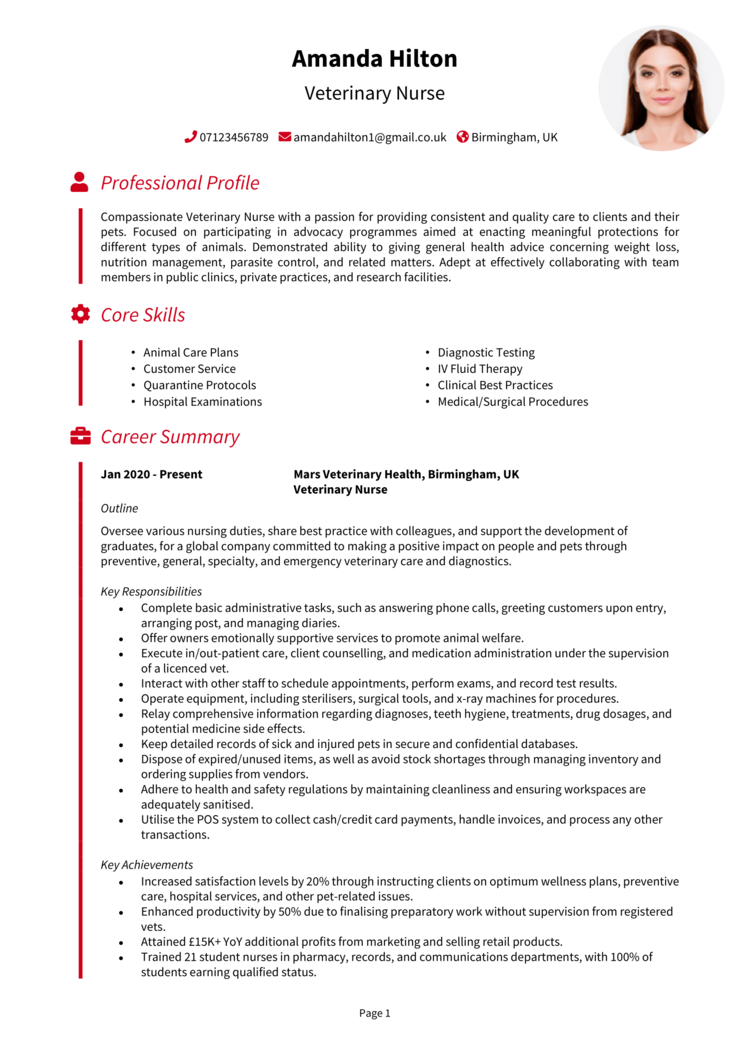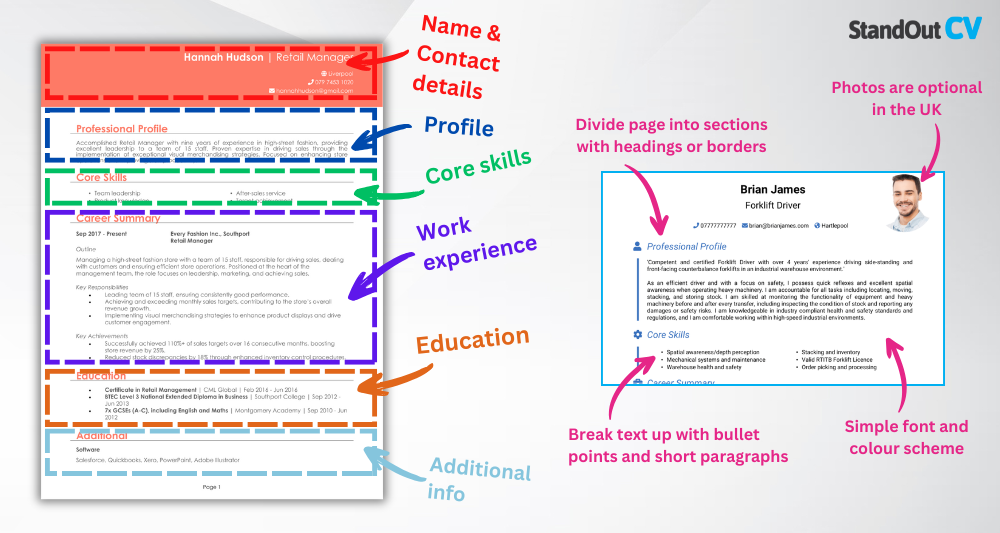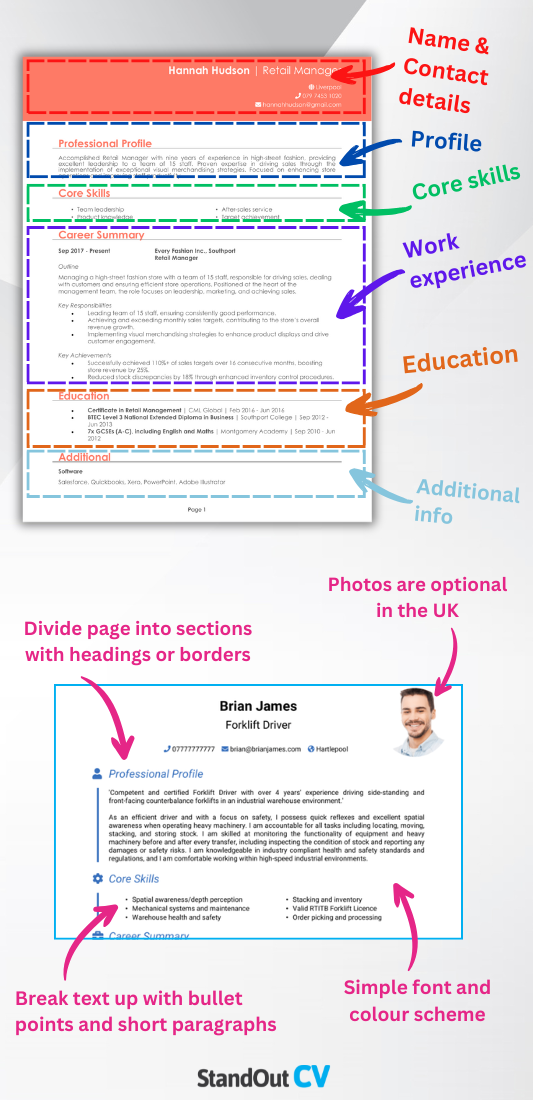Every practice runs smoother when there’s a skilled vet nurse on hand. You’re the vital presence which animals and owners rely on: but no one will know that unless your CV makes it immediately clear.
Whether you’re applying for a general practice or something more specialist, this guide (and its Veterinary Nurse CV example) will help you put together an application that earns trust and lands you the vet roles you deserve.
Veterinary Nurse CV sample

How to write your Veterinary Nurse CV
Discover how to craft a winning Veterinary Nurse CV that lands interviews with this simple step-by-step guide.
A great CV for a vet nurse isn’t about fluff – it’s about clarity and competence. Practices want someone who can handle the technical tasks and the emotional ones, and your CV is your first chance to prove you’ve got both covered.
Over the next few sections, you’ll learn about writing a CV which organises your experience and presents your qualifications to speak confidently to your strengths – whether you’ve just qualified or have years of experience under your belt.
The correct structure and formatting for a Veterinary Nurse CV


Whether it’s prepping for surgery or managing patient records, structure matters in vet nursing – and it matters just as much in your CV. Recruiters and practice managers need to see your training, experience, and practical skills clearly, so it’s important that your layout is straightforward and easy to scan.
Here’s the layout to follow:
- Name and contact details – Keep these personal details at the top so a potential employer can reach out to you.
- Profile – Immediately draw in the recruiter with a brief summary of your skills and experience.
- Core skills – Quickly list your biggest strengths.
- Work experience – Walk through your employment history in reverse chronological order.
- Education & certifications – List the qualifications and certificates that make you the right fit.
- Additional info – You can optionally list any relevant hobbies and interests which help to convey you fit for the role.
Use bullet points throughout your entire format to make your responsibilities and achievements clear. Headings should be bold and consistent so your CV flows logically. Stick to a clean, readable font and keep everything within a length of two pages. Presentation counts – it shows you’re professional and detail-focused, just like in your day-to-day role.
CV profile for a Veterinary Nurse


You may be working behind the scenes in the treatment room, but your profile should step right into the spotlight. This brief summary is your chance to show practices what they can expect when they hire you: someone who brings clinical competence and calmness under pressure. Ultimately, your CV profile should show recruiters that you’re someone who will bring genuine value to the role.
Veterinary Nurse CV profile examples
Profile 1
Compassionate and dedicated Veterinary Nurse with five years of experience supporting veterinary surgeons in small animal practices. Skilled in surgical preparation, patient monitoring, and post-operative care. Proficient in handling and restraining animals, administering medication, and maintaining accurate clinical records. Known for delivering calm, reassuring care to pets and their owners during stressful situations.
Profile 2
Reliable and detail-oriented Registered Veterinary Nurse with experience in preventative care, inpatient nursing, and client education. Strong knowledge of veterinary procedures, infection control, and pharmacy duties. Passionate about animal welfare and committed to maintaining high clinical standards in every aspect of care.
Profile 3
Experienced Veterinary Nurse with four years of hands-on practice in mixed animal clinics, including emergency and out-of-hours care. Confident in assisting during diagnostic procedures, triaging incoming patients, and supporting anaesthesia monitoring. Adept in working collaboratively with veterinary teams while ensuring the comfort and wellbeing of animals in recovery.
Details to put in your Veterinary Nurse CV profile
Here’s some tips on what to include:
- Where you’ve worked – Small animal practices, hospitals, mixed practice, or specialist clinics.
- Your top qualifications – Diploma or degree in veterinary nursing, plus RCVS registration.
- Essential skills – Clinical procedures, anaesthesia monitoring, record keeping, client communication.
- Special interests – Behavioural care, surgical assistance, inpatient care, or exotic animals.
- Patient care approach – Calm under pressure, compassionate with owners, confident supporting veterinary teams.
How should you write a core skills section?


This section helps practices quickly identify where your strengths lie. Use it to show both technical know-how and the softer skills that are essential in clinical environments. Avoid simply listing traits – focus instead on CV skills that reflect your working style, responsibilities, and how you interact with both patients and people. Tailor this section to match the job you’re applying for.
Key skills for a Veterinary Nurse CV
- Animal Care and Monitoring – Providing day-to-day care for inpatients, including feeding, grooming, and monitoring vital signs.
- Surgical Assistance – Supporting veterinarians during procedures by preparing instruments, monitoring anaesthesia, and assisting in surgery.
- Medication Administration – Dispensing and administering medications, including injections and oral treatments, under veterinary supervision.
- Diagnostic Testing Support – Collecting samples, conducting basic laboratory tests, and preparing specimens for analysis.
- Wound and Post-Operative Care – Cleaning wounds, changing dressings, and monitoring recovery to promote healing and prevent complications.
- Client Communication and Education – Explaining treatment plans, medication schedules, and post-care instructions to pet owners.
- Animal Restraint and Handling – Safely handling animals during exams or procedures to minimise stress and prevent injury.
- Record Keeping and Administration – Maintaining accurate patient records, updating treatment logs, and processing billing or insurance information.
- Infection Control and Hygiene Maintenance – Ensuring all clinical areas, instruments, and equipment are sanitised and compliant with health standards.
- Emergency Response Support – Assisting in urgent care situations, including resuscitation and stabilisation of critically ill animals.
Writing about your work experience


Your work experience section is where everything comes together. This is your opportunity to show that you’ve done more than just clock shifts – you’ve made a real difference to clients and your colleagues. Think beyond basic duties and focus on the specific tasks that show your value.
Start with your most recent role and work backward. For each job, give your title, the practice name, and your dates of employment. Then, use bullet points to highlight your contributions – whether that’s patient care, surgical assistance, team coordination, or something else that demonstrates the unique value you bring to a clinic.
Formatting your job history for your CV

- Outline – Give context about the type of clinic or hospital and the services provided.
- Responsibilities – Use action words like “assisted,” “monitored,” “prepared,” or “supported.”
- Achievements – Highlight real impact, such as “streamlined pre-op procedures,” “improved patient handling protocols,” or “mentored new student nurses.”
Work experience samples for Veterinary Nurses
Veterinary Nurse | Oakvale Clinic
Outline
Supported daily clinical operations in a busy small animal practice, assisting with consultations, surgical procedures, and inpatient care.
Responsibilities
- Prepared animals for surgery and monitored anaesthesia during operations.
- Provided post-operative care and ensured patients’ recovery in kennels.
- Assisted in x-rays, blood draws, and laboratory sample handling.
- Maintained accurate clinical records and updated patient charts.
- Educated pet owners on treatment plans, nutrition, and follow-up care.
Achievements
- Reduced surgical preparation time by 20% through improved procedural organisation.
- Recognised for consistently calm handling of nervous or distressed animals.
- Trained two student veterinary nurses on inpatient care protocols.
Veterinary Nurse | Harbour Lane Vets
Outline
Provided nursing care for small animals at a multi-site veterinary practice, supporting preventative care programmes and outpatient services.
Responsibilities
- Conducted nurse-led clinics including weight management, dental checks, and microchipping.
- Prepared medications and dispensed prescriptions under veterinary direction.
- Maintained inventory of medical supplies and assisted with stock rotation.
- Participated in practice open days and community education initiatives.
- Recorded clinical notes and ensured compliance with RCVS and practice standards.
Achievements
- Increased clinic uptake by 35% after launching a new preventative health programme.
- Achieved 100% audit compliance in quarterly infection control reviews.
- Played a key role in achieving ISFM Cat Friendly Clinic Silver accreditation.
Veterinary Nurse | Willowbrook Animal Hospital
Outline
Worked in a 24-hour hospital setting providing routine, emergency, and post-surgical care to a wide variety of domestic pets and wildlife cases.
Responsibilities
- Monitored critical care patients and administered IV fluids and medications.
- Assisted veterinary surgeons during emergency procedures and diagnostic imaging.
- Managed sterilisation of surgical instruments and maintained theatre hygiene standards.
- Provided overnight monitoring and comfort care for hospitalised animals.
- Supported discharge appointments with client demonstrations and treatment explanations.
Achievements
- Helped improve patient monitoring protocols, reducing recovery times for post-op cases.
- Supported successful hand-rearing of neonatal patients during out-of-hours care.
- Acknowledged by management for exceptional teamwork and night-shift reliability.
How to write your education section


Your education and qualifications confirm you’re fully trained, legally registered, and up to date with best practice in animal care. Start with your most recent qualification – usually a Level 3 Diploma or BSc in Veterinary Nursing – followed by any short courses, CPD, or professional memberships.
Even if you’re newly qualified, include any hands-on training, placements, or specialist modules you completed. This shows you’re confident working in clinical settings and willing to keep learning.
Recommended qualifications for Veterinary Nurses
- Level 3 Diploma in Veterinary Nursing – The minimum requirement for registration and clinical practice.
- BSc (Hons) in Veterinary Nursing – Combines practical training with deeper academic and research skills.
- RCVS Registered Veterinary Nurse (RVN) Status – Essential for practising as a qualified vet nurse in the UK.
- Certificate in Emergency and Critical Care (Vets Now or similar) – Adds value for nurses in fast-paced clinical settings.
- CPD Courses in Anaesthesia, Dentistry, or Behaviour – Shows commitment to developing specialisms within the field.





